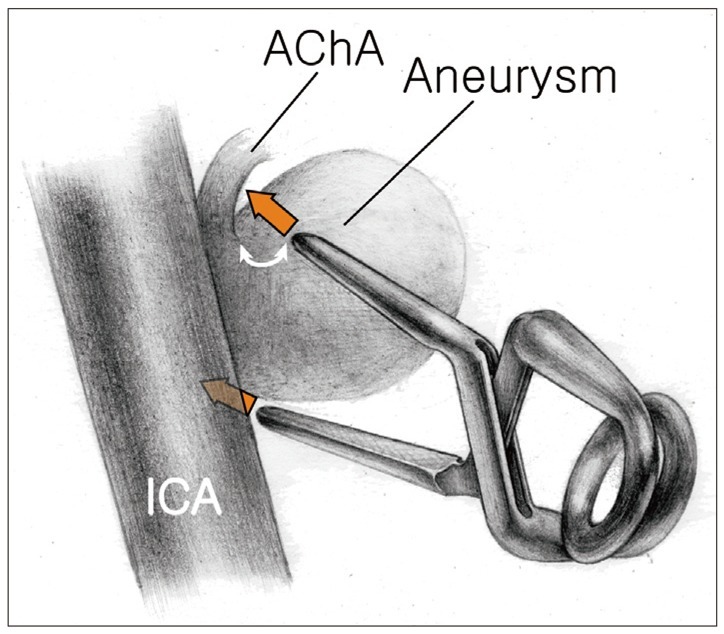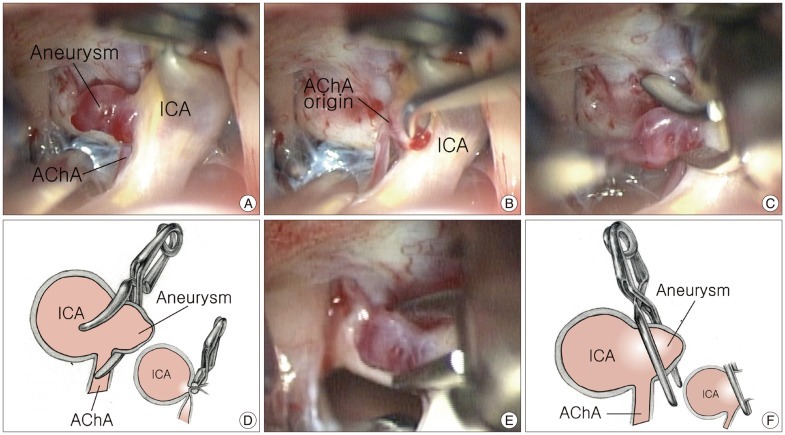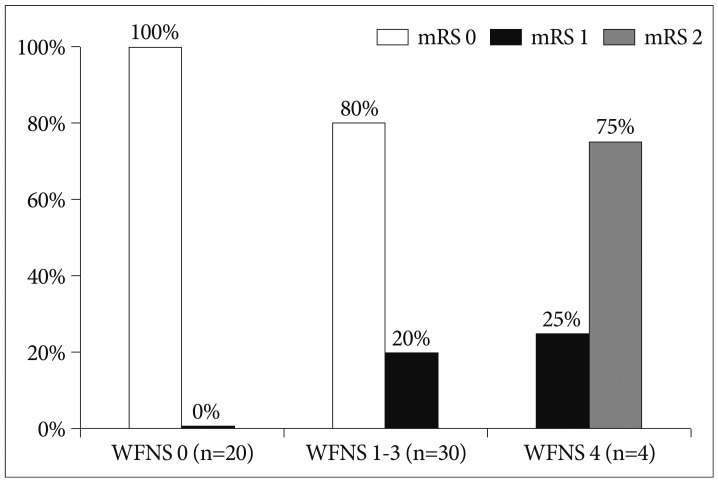Anterior Choroidal Artery Aneurysm Surgery: Ischemic Complications and Clinical Outcomes Revisited
- Affiliations
-
- 1Department of Neurosurgery, Cardiocerebrovascular Center, Kyungpook National University, Daegu, Korea. jparkmd@hotmail.com
- KMID: 1814243
- DOI: http://doi.org/10.3340/jkns.2013.54.2.86
Abstract
OBJECTIVE
Surgical results for anterior choroidal artery (AChA) aneurysms have previously been reported as unsatisfactory due to inadvertent occlusion of the AChA, while the low incidence of AChA aneurysms hampers the accumulation of surgical experience. The authors reviewed their related surgical experience to document the ischemic complications and surgical outcomes.
METHODS
Identification of the AChA at its origin by rigorous visual scrutiny, careful microdissection, and meticulous clip placement to avoid the AChA origin are all crucial surgical maneuvers. A retrospective review of a surgical series of 62 consecutive cases of an AChA aneurysm between 2004 and 2012 was performed.
RESULTS
All patients, except for five (8.1%) with a small residual neck, showed complete aneurysm obliteration in postoperative angiographic evaluations. There was no incidence of procedure-related permanent AChA syndrome or oculomotor nerve palsy, while three (4.8%) patients suffered from transient AChA syndrome. The clinical outcomes [the 3-month modified Rankin Scale (mRS)] of the patients were related to their preoperative World Federation of Neurologic Surgeons (WFNS) grade. As regards the 3-month mRS, significant differences were found between patients with an unruptured aneurysm (WFNS grade 0; n=20), good-grade subarachnoid hemorrhage (WFNS grade 1-3; n=30), and poor-grade subarachnoid hemorrhage (WFNS grade 4-5; n=4).
CONCLUSION
In surgical treatment of AChA aneurysms, a risk of AChA insufficiency can be minimized by taking every precaution to preserve the AChA patency and intraoperative monitoring. In addition, the surgical outcome is primarily determined by the preoperative clinical state.
Keyword
MeSH Terms
Figure
Cited by 3 articles
-
Supraorbital Keyhole Approach for Intracranial Aneurysms : Transitioning from Concerns to Confidence
Jaechan Park
J Korean Neurosurg Soc. 2020;63(1):4-13. doi: 10.3340/jkns.2019.0042.Usefulness of Motor-Evoked Potentials Monitoring for Neurosurgical Treatment of an Unusual Distal Anterior Choroidal Artery Aneurysm
Charles Champeaux, Vincent Jecko, Sandrine Eimer, Guillaume Penchet
J Korean Neurosurg Soc. 2016;59(4):414-419. doi: 10.3340/jkns.2016.59.4.414.Efficacy of intraoperative neuromonitoring (IONM) and intraoperative indocyanine green videoangiography (ICG-VA) during unruptured anterior choroidal artery aneurysm clipping surgery
Chanbo Eun, Seung Joo Lee, Jung Cheol Park, Jae Sung Ahn, Byung Duk Kwun, Wonhyoung Park
J Cerebrovasc Endovasc Neurosurg. 2023;25(2):150-159. doi: 10.7461/jcen.2023.E2022.10.008.
Reference
-
1. Cho MS, Kim MS, Chang CH, Kim SW, Kim SH, Choi BY. Analysis of Clip-induced Ischemic Complication of Anterior Choroidal Artery Aneurysms. J Korean Neurosurg Soc. 2008; 43:131–134. PMID: 19096619.
Article2. Dashti R, Laakso A, Niemelä M, Porras M, Hernesniemi J. Microscope-integrated near-infrared indocyanine green videoangiography during surgery of intracranial aneurysms: the Helsinki experience. Surg Neurol. 2009; 71:543–550. discussion 550. PMID: 19328531.
Article3. Fischer G, Stadie A, Oertel JM. Near-infrared indocyanine green videoangiography versus microvascular Doppler sonography in aneurysm surgery. Acta Neurochir (Wien). 2010; 152:1519–1525. PMID: 20623360.
Article4. Flamm ES. Other aneurysms of the internal carotid artery. In : Wilkins RH, Rengachary SS, editors. Neurosurgery. New York: McGraw-Hill;1996. p. 2301–2310.5. Friedman JA, Pichelmann MA, Piepgras DG, Atkinson JL, Maher CO, Meyer FB, et al. Ischemic complications of surgery for anterior choroidal artery aneurysms. J Neurosurg. 2001; 94:565–572. PMID: 11302654.
Article6. Furtado SV, Venkatesh PK, Hegde AS. Neurological complications and surgical outcome in patients with anterior choroidal segment aneurysms. Int J Neurosci. 2010; 120:291–297. PMID: 20374077.
Article7. Irie T, Yoshitani K, Ohnishi Y, Shinzawa M, Miura N, Kusaka Y, et al. The efficacy of motor-evoked potentials on cerebral aneurysm surgery and new-onset postoperative motor deficits. J Neurosurg Anesthesiol. 2010; 22:247–251. PMID: 20548170.
Article8. Kang HS, Kwon BJ, Kwon OK, Jung C, Kim JE, Oh CW, et al. Endovascular coil embolization of anterior choroidal artery aneurysms. Clinical article. J Neurosurg. 2009; 111:963–969. PMID: 19463045.9. Kim BM, Kim DI, Chung EC, Kim SY, Shin YS, Park SI, et al. Endovascular coil embolization for anterior choroidal artery aneurysms. Neuroradiology. 2008; 50:251–257. PMID: 17994230.
Article10. Kim BM, Kim DI, Shin YS, Chung EC, Kim DJ, Suh SH, et al. Clinical outcome and ischemic complication after treatment of anterior choroidal artery aneurysm: comparison between surgical clipping and endovascular coiling. AJNR Am J Neuroradiol. 2008; 29:286–290. PMID: 18024579.
Article11. Li J, Mukherjee R, Lan Z, Liu Y, He M. Microneurosurgical management of anterior choroidal artery aneurysms: a 16-year institutional experience of 102 patients. Neurol Res. 2012; 34:272–280. PMID: 22449861.
Article12. Park J, Kang DH, Chun BY. Superciliary keyhole surgery for unruptured posterior communicating artery aneurysms with oculomotor nerve palsy: maximizing symptomatic resolution and minimizing surgical invasiveness. J Neurosurg. 2011; 115:700–706. PMID: 21699478.
Article13. Park J, Woo H, Kang DH, Sung JK, Kim Y. Superciliary keyhole approach for small unruptured aneurysms in anterior cerebral circulation. Neurosurgery. 2011; 68(2 Suppl Operative):300–309. discussion 309. PMID: 21346651.
Article14. Park JH, Kim JE, Sheen SH, Jung CK, Kwon BJ, Kwon OK, et al. Intraarterial abciximab for treatment of thromboembolism during coil embolization of intracranial aneurysms: outcome and fatal hemorrhagic complications. J Neurosurg. 2008; 108:450–457. PMID: 18312090.
Article15. Piotin M, Mounayer C, Spelle L, Williams MT, Moret J. Endovascular treatment of anterior choroidal artery aneurysms. AJNR Am J Neuroradiol. 2004; 25:314–318. PMID: 14970038.16. Senturk C, Bandeira A, Bruneau M, Dewindt A, Balériaux D, De Witte O, et al. Endovascular treatment of anterior choroidal artery aneurysms. J Neuroradiol. 2009; 36:228–232. PMID: 19766311.
Article17. Shibata Y, Fujita S, Kawaguchi T, Hosoda K, Komatsu H, Tamaki N. Use of microvascular Doppler sonography in aneurysm surgery on the anterior choroidal artery. Neurol Med Chir (Tokyo). 2000; 40:30–35. discussion 35-37. PMID: 10721253.
Article18. Suzuki K, Kodama N, Sasaki T, Matsumoto M, Konno Y, Sakuma J, et al. Intraoperative monitoring of blood flow insufficiency in the anterior choroidal artery during aneurysm surgery. J Neurosurg. 2003; 98:507–514. PMID: 12650421.
Article19. Yasargil MG. Microneurosurgery: Clinical Considerations, Surgery of the Intracranial Aneurysms and Results. New York: Thieme;1984. 2:p. 99–108.20. Yasargil MG, Yonas H, Gasser JC. Anterior choroidal artery aneurysms: their anatomy and surgical significance. Surg Neurol. 1978; 9:129–138. PMID: 625698.
- Full Text Links
- Actions
-
Cited
- CITED
-
- Close
- Share
- Similar articles
-
- Transposition of Anterior Choroidal Artery and Posterior Communicating Artery Origin
- Flow recovery after posterior clinoidectomy for surgical clipping of anterior choroidal aneurysm
- Clinical Experiences of Anterior Choroidal Artery Aneurysm
- Oculomotor Nerve Palsy due to Ruptured Multiple Anterior Choroidal Artery Aneurysms
- Ischemic Complication of Ruptured Anterior Choroidal Artery Aneurysm






